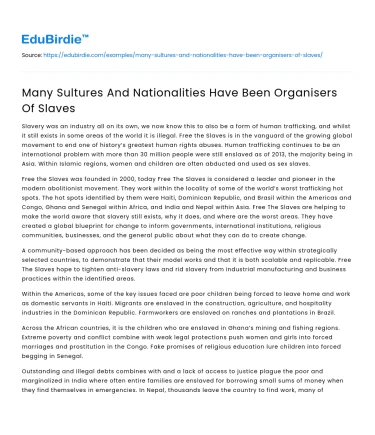Slavery was an industry all on its own, we now know this to also be a form of human trafficking, and whilst it still exists in some areas of the world it is illegal. Free the Slaves is in the vanguard of the growing global movement to end one of history’s greatest human rights abuses. Human trafficking continues to be an international problem with more than 30 million people were still enslaved as of 2013, the majority being in Asia. Within Islamic regions, women and children are often abducted and used as sex slaves.
Free the Slaves was founded in 2000, today Free The Slaves is considered a leader and pioneer in the modern abolitionist movement. They work within the locality of some of the world’s worst trafficking hot spots. The hot spots identified by them were Haiti, Dominican Republic, and Brasil within the Americas and Congo, Ghana and Senegal within Africa, and India and Nepal within Asia. Free The Slaves are helping to make the world aware that slavery still exists, why it does, and where are the worst areas. They have created a global blueprint for change to inform governments, international institutions, religious communities, businesses, and the general public about what they can do to create change.
Save your time!
We can take care of your essay
- Proper editing and formatting
- Free revision, title page, and bibliography
- Flexible prices and money-back guarantee
A community-based approach has been decided as being the most effective way within strategically selected countries, to demonstrate that their model works and that it is both scalable and replicable. Free The Slaves hope to tighten anti-slavery laws and rid slavery from industrial manufacturing and business practices within the identified areas.
Within the Americas, some of the key issues faced are poor children being forced to leave home and work as domestic servants in Haiti. Migrants are enslaved in the construction, agriculture, and hospitality industries in the Dominican Republic. Farmworkers are enslaved on ranches and plantations in Brazil.
Across the African countries, it is the children who are enslaved in Ghana’s mining and fishing regions. Extreme poverty and conflict combine with weak legal protections push women and girls into forced marriages and prostitution in the Congo. Fake promises of religious education lure children into forced begging in Senegal.
Outstanding and illegal debts combines with and a lack of access to justice plague the poor and marginalized in India where often entire families are enslaved for borrowing small sums of money when they find themselves in emergencies. In Nepal, thousands leave the country to find work, many of them are tricked into this by traffickers.






 Stuck on your essay?
Stuck on your essay?

